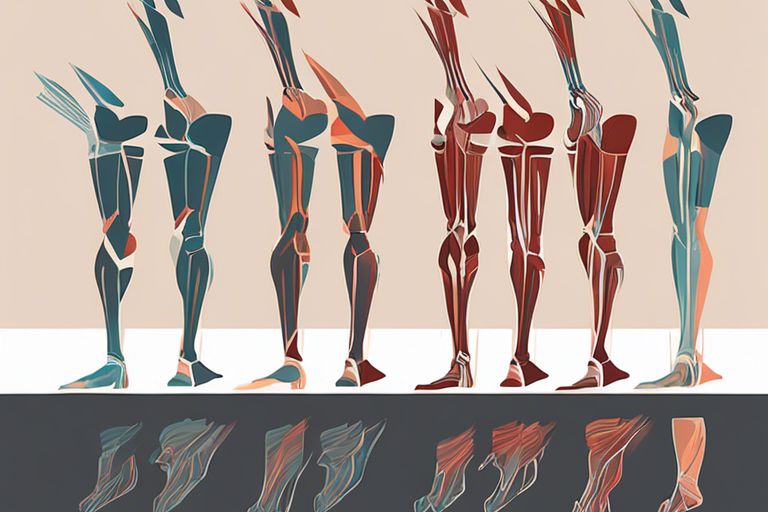Have you ever wondered how walking can impact your muscle tone? Walking is a highly effective way to improve muscle tone throughout your body, particularly in the legs, buttocks, and core muscles. When you walk, the muscles in your body are constantly contracting and relaxing, which helps to strengthen and tone them over time. Additionally, walking is a low-impact exercise that is gentle on the joints, making it a safe and accessible way to improve muscle tone for individuals of all ages and fitness levels. Not only does walking increase muscle tone, but it also burns calories and helps to improve overall cardiovascular health, making it an incredibly beneficial activity for your entire body.
The Science of Walking and Muscle Tone
As you walk, the rhythmic contraction and relaxation of your muscles work together to propel you forward. This repetitive movement not only helps you cover distances but also plays a significant role in toning your muscles. Let’s delve into the science of how walking affects muscle tone.
Understanding Muscle Contractions
When you walk, your muscles contract and relax in a coordinated manner to produce movement. This rhythmic process helps to strengthen and tone your muscles. The repetitive contractions involved in walking, such as those in your calves, quadriceps, and glutes, help to improve muscle tone and definition. Additionally, walking engages various muscle groups, promoting overall muscle development and toning. Stronger muscles not only contribute to a leaner appearance but also support your skeletal structure and improve posture, reducing the risk of injury.
The Role of Walking in Muscular Endurance
Walking regularly also improves your muscular endurance, allowing you to sustain physical activity for longer periods without experiencing fatigue. This is achieved through the repeated contraction and relaxation of muscles during walks, which helps to build stamina and endurance over time. By continuing to challenge your muscles through walking, you can increase your overall physical capacity, making everyday activities easier and reducing the risk of muscle strain or injury. Additionally, improved muscular endurance enhances your performance in other physical activities, allowing you to push your limits and achieve new fitness goals.
Walking Techniques for Enhanced Muscle Tone
Assuming you have made walking a regular part of your fitness routine, it’s time to focus on specific techniques that can help enhance muscle tone. By paying attention to your walking posture, incorporating inclines and speed variations, you can maximize the benefits of walking for muscle tone.
Proper Walking Posture
When it comes to walking for muscle tone, proper posture is essential. Keep your head up, shoulders back, and abdomen tight to engage your core muscles. Make sure your arms are swinging naturally and that you are striking the ground with your heel and rolling through to your toe with each step. By maintaining proper walking posture, you can engage multiple muscle groups, including your core, glutes, and legs, leading to improved muscle tone over time.
Incorporating Inclines and Speed Variations
Adding inclines and speed variations to your walking routine can intensify the muscle-toning benefits of walking. When you walk uphill, you are engaging your leg muscles more intensely, leading to greater muscle activation and toning. Similarly, varying your walking speed can challenge your muscles in different ways, leading to improved muscle tone and strength. By incorporating inclines and speed variations, you keep your muscles guessing and prevent plateauing in your fitness progress.
The Impact of Consistency and Duration
Unlike sporadic exercise, consistent walking over an extended period of time can lead to significant improvements in muscle tone. Your muscles respond to the regular physical activity by becoming stronger and more toned. The duration of your walking sessions also plays a crucial role in shaping your muscle tone.
Short-Term vs Long-Term Walking Regimens
When it comes to muscle tone, short-term walking regimens may provide some immediate benefits such as improved circulation and a temporary increase in muscle tone. However, for long-lasting changes, a sustained walking routine over an extended period of time is essential. Over time, this consistent effort will lead to more noticeable and enduring improvements in muscle tone.
Frequency and Duration Recommendations for Optimal Results
To achieve optimal muscle tone, it is recommended that you engage in brisk walking for at least 30 minutes a day, most days of the week. This level of frequency and duration will help ensure that your muscles are consistently challenged and given the opportunity to grow stronger. For even greater results, consider incorporating strength training exercises along with your walking regimen to specifically target and tone different muscle groups.

Additional Factors Influencing Muscle Tone
After walking regularly, there are additional factors that can influence your muscle tone. These factors can play a significant role in how your muscles respond to the exercise and contribute to the overall health and tone of your muscles. Recognizing these factors can help you optimize your walking routine for improved results.
- Nutrition and Hydration: Your nutrition and hydration levels can have a direct impact on your muscle tone. Proper nutrition provides the essential nutrients your muscles need to stay strong and toned, while hydration is crucial for muscle function and recovery.
- Cross-Training and Rest: In addition to walking, engaging in cross-training activities can complement your routine and improve overall muscle tone. Rest and recovery are also essential for muscle repair and growth, so it’s important to incorporate adequate rest periods into your exercise routine.
Nutrition and Hydration
Proper nutrition and hydration are crucial for maintaining and improving muscle tone. When you walk, your muscles require the right balance of nutrients to repair and build new muscle tissue. Consuming a diet rich in protein, healthy fats, and complex carbohydrates can support muscle tone. Additionally, staying hydrated is essential for maintaining optimal muscle function and preventing muscle fatigue during your walking sessions. Be sure to drink an adequate amount of water throughout the day, especially before and after exercise, to keep your muscles functioning at their best.
Cross-Training and Rest
Incorporating cross-training activities into your walking routine can have a positive impact on your overall muscle tone. Engaging in activities such as strength training, yoga, or pilates can target different muscle groups and help improve overall muscle tone. It’s also important to allow for adequate rest and recovery time between walking sessions. Your muscles need time to repair and rebuild, so be sure to incorporate rest days into your exercise routine to prevent overtraining and promote muscle growth.
How does walking affect muscle tone?
Ultimately, walking is a great way to improve muscle tone in your lower body. As you walk, the muscles in your legs, glutes, and core are constantly engaged to support your body and propel you forward. This regular, low-impact exercise helps to strengthen and tone these muscles over time. Additionally, walking can also improve your overall posture and coordination, leading to better muscle tone throughout your entire body. So, if you’re looking to improve muscle tone without putting too much strain on your body, incorporating walking into your exercise routine can be a great option.




